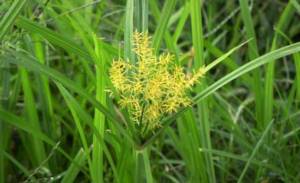The Invasion Of Yellow Nutsedge
 Yellow nutsedge is a major weed that used to be only found in the South, but has made its way North. It is a grass like weed in the sedge family with top growth that reaches 8 to 30 inches tall. Yellow nutsedge has an extensive underground network of basal bulbs, roots, thin fibrous rhizomes, and tubers. The leaves are mostly basal and are bright green to yellow green and bears the inflorescence flower heads. The inflorescence are yellow to brown and consists of spikes borne on 1 to 3 inches of stalks unequal in length.
Yellow nutsedge is a major weed that used to be only found in the South, but has made its way North. It is a grass like weed in the sedge family with top growth that reaches 8 to 30 inches tall. Yellow nutsedge has an extensive underground network of basal bulbs, roots, thin fibrous rhizomes, and tubers. The leaves are mostly basal and are bright green to yellow green and bears the inflorescence flower heads. The inflorescence are yellow to brown and consists of spikes borne on 1 to 3 inches of stalks unequal in length.
Dormancy in yellow nutsedge is broken by chilling at 40–50°F for several weeks. Sprouting will begin as soil temperatures rise above 55°F. Tubers can remain dormant and survive up to 4 years.
In Copley, Ohio Yellow nutsedge begins active growth in late spring. A rhizome emerges from the tuber and grows toward the surface of the soil. When the rhizome receives a light stimulus a basal bulb will then form. The shoot that formed will consist of a cluster of basal leaves from this bulb. Then a fibrous root system will develop from basal bulbs and rhizomes.
Plant development
Yellow nutsedge remains attached to the mother tuber for up to 10-12 weeks. Within four weeks after initial shoot emerges new rhizomes emerge from the basal bulb and grow up to 20 inches laterally. This will happen over and over again forming new basal bulbs and daughter plants. Yellow nutsedge will continue to spread exponentially in the absence of competition or control measures and will also spread by seed developed in mature plants.
In temperate zone populations of yellow nutsedge, shortening day length in late summer triggers flowering and tuber production. When day length decreases to about 14 hours, rhizome tips begin to form tubers rather than new daughter plants. While top growth slows, prolific tuber production continue to form until frost kills them. Tubers will form as deep as 18 inches.
Where does it grow?
Yellow nutsedge thrives in moist to wet conditions and can tolerate flooding. It can be incredibly prolific in temperate climates with high moisture soils. A single tuber has been observed to give rise to 1,900 shoots and 6,900 tubers within one year in Minnesota and 1,700–3,000 shoots and 19–20 thousand tubers in irrigated fields in Oregon forming a dense patch 6 feet across. Tuber dry weight reached an equivalent of about 4 tons per acre.
Yellow nutsedge tubers are killed by exposure for 1–2 days to temperatures of 113–122°F or below 20°F. Most tubers within 2 inches of the soil surface are winter killed but the weed readily emerges from tubers located 4 inches or deeper where they are protected from temperatures extremes. Yellow nutsedge has successfully spread into southeastern Canada, where snow cover has protected tubers from winterkill.
Yellow nutsedge can tolerate moderate shade with little decrease in growth or tuber production, whereas dense shade reduces total biomass by more than half. Although the weed compensates for shade by growing even taller, and can form some tubers even under 94% shade, competition for light is recognized as an important tactic that can enhance the efficacy.
Yellow nutsedge can form viable seeds by cross-pollination. As many as 1,500 viable seeds per plant and the seedlings can establish successfully only when the soil surface remains continuously moist.
As you can see Yellow nutsedge is not a weed to ignore in your Copley lawn and should be treated immediately. A delay in the treatment can become catastrophic very quickly.